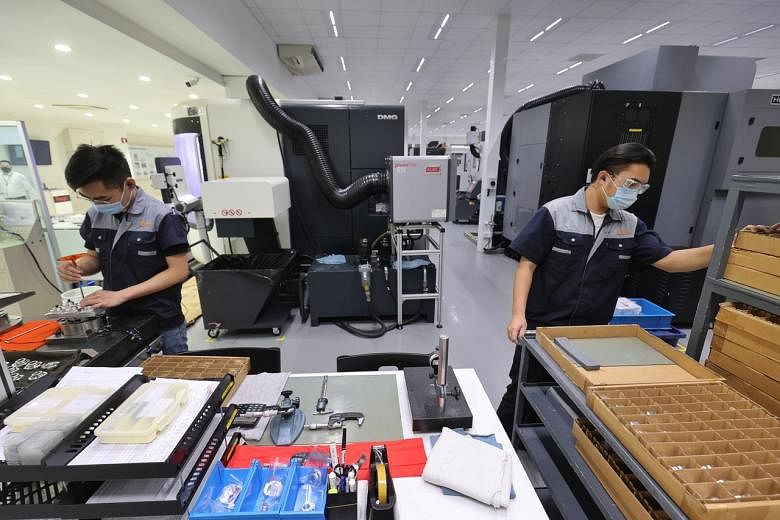SINGAPORE - Private-sector economists tempered their 2020 outlook for Singapore's economy but turned more bullish over the strength of a recovery through next year, suggesting the worst of the coronavirus-induced contraction has passed.
The economy may shrink by 6 per cent this year, according to a quarterly survey of 26 economists and analysts by the Monetary Authority of Singapore (MAS), slightly worse than the 5.8 per cent contraction predicted in the previous June survey.
However, the professional forecasters expected growth in gross domestic product to recover to 5.5 per cent in 2021, up from the 4.8 per cent they had tipped earlier, MAS said in its survey report released on Monday (Sept 7).
The Ministry of Trade and Industry (MTI) last month lowered its outlook for the fifth time this year, with the economy now forecast to shrink by 5 per cent to 7 per cent. This would make this year's recession Singapore's worst since independence. So far, there is no official forecast for 2021.
Ms Selena Ling, OCBC Bank's head of treasury research and strategy, said that there is still a significant degree of uncertainty attached to the 2021 outcome, as cautioned by many policymakers worldwide.
"Even assuming 5.5 per cent growth in 2021, the value of Singapore GDP will not return to the 2019 pre-Covid levels," she said.
OCBC's 2021 GDP growth forecast is at a more conservative 4 per cent, depending on the speed and geographical availability of Covid-19 vaccine which could in turn buoy the external economic environment, Ms Ling added.
The downgrade of the full-year 2020 GDP in the latest MAS survey was predicated on weaker outlook for construction, accomodation and food services, and private consumption. However, median forecasts improved for manufacturing, finance and insurance, wholesale and retail trade, and non-oil domestic exports over the June survey.
Ms Ling of OCBC said; "The rationale for these forecast revisions can be attributed to the strong risk-on sentiments since the re-opening of global/domestic economies since June, the dovish commitments by major central banks to keep monetary policy accommodative for longer, and the yield-seeking investor behaviour due to the very low interest rate environment, which has aided activities in the finance and insurance segment."
In addition, pent-up domestic demand since the local economy moved into the Phase 2 reopening stage has buoyed retail sales, she noted.
For the third quarter of this year, the analysts expected the economy to contract by 7.6 per cent year on year, easing from the record 13.2 per cent plunge in the second quarter.
MTI is likely to issue advance estimates later this month for the period from July to September.
A further deterioration in the coronavirus situation, due to further waves of outbreaks or delays in vaccine development, topped the list of downside risks to Singapore's growth outlook identified in the survey.
Ninety per cent of the respondents cited the risk of a secondary outbreak and 75 per cent ranked it as the top downside risk.
An escalation in United States-China tensions was identified by 60 per cent as a downside risk, compared with 55.6 per cent in the previous survey.
Respondents were also concerned about risks stemming from a slower-than-expected global economic recovery, with 25 per cent identifying it as a risk, up from 16.7 per cent in the earlier survey.
Meanwhile, the containment of the Covid-19 outbreak - due, for instance, to the successful global deployment of a vaccine - again emerged as the most frequently cited upside risk to Singapore's growth outlook. Seventy-five per cent of the respondents listed it and 60 per cent ranked it as the top upside risk.
Respondents also identified stronger-than-expected manufacturing sector performance, led by electronics and pharmaceuticals production, as a key upside risk. This was identified by 40 per cent of respondents, compared with 55.6 per cent in the previous survey.
In addition, 30 per cent of respondents flagged easing US-China tensions as a potential upside risk to the outlook, up from 16.7 per cent in the previous survey.
Taking the mean probability distribution in the latest MAS survey, the most likely outcome for the Singapore economy is a contraction of 5.1 per cent to 7 per cent this year, with a 62.2 per cent average probability assigned to this range.
In the June survey, the most likely outcome for 2020 had been projected at minus 6 per cent to minus 4.1 per cent, with an average probability of 53.3 per cent.
For the labour market, the respondents expected the seasonally adjusted unemployment rate to ease slightly to 3.5 per cent at the end of this year, from 3.6 per cent in the previous survey.
The CPI-All items inflation and MAS core inflation for the third quarter of this year are expected to come in at minus 0.6 per cent and minus 0.4 per cent respectively.
Corporate profitability, in the third quarter as well as for the whole of 2020, is expected to decline.
Two-thirds of the respondents forecast that private residential property prices will drop quarter-on-quarter during the July-Sept period, 22.2 per cent expected prices to remain stable, and 11.1 per cent predicted an increase.
For the whole of 2020, more than half believed private residential property prices will decline.
For 2021, the survey respondents expect an improvement in corporate profitability, with 88.9 per cent predicting an increase. Meanwhile, 44.4 per cent expect private residential property prices to rise next year.



